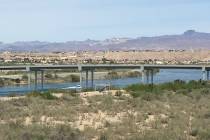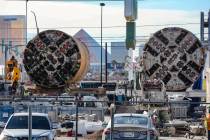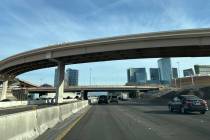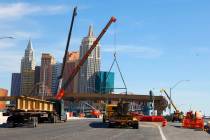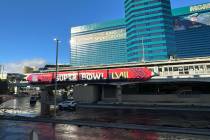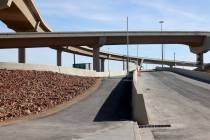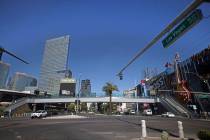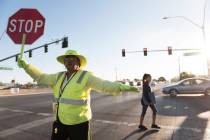Long waits are here for travelers using I-15 through Virgin River Canyon gorge

If you’re planning a road trip to Utah or Colorado on Interstate 15 in the next couple of years, be sure to have the snacks and car games in reach after you’ve zipped through Mesquite.
You could be in for a long wait.
The Arizona Department of Transportation has begun work on a major overhaul of I-15 through the Virgin River Canyon gorge about 85 miles northeast of Las Vegas.
It’s the largest project in more than 40 years on a real geographic oddity — a 29-mile stretch of interstate highway with just three exits, none of which serve any major commerce.
Arizona’s portion of the highway through the gorge is an engineering marvel filled with spectacular vistas. In some locations, the limestone cliffs tower 500 feet above the highway.
When the old U.S. Highway 91, which I-15 bypassed, was built, engineers didn’t dare traverse the canyon with a road. It was too steep, too narrow, too treacherous and subject to flash floods.
When I-15 builders took on the challenge, the route cost more to build than any other rural highway on the interstate system at $10 million per mile when it opened in 1973.
Much of the construction challenge has been in building and maintaining seven bridges over the Virgin River.
The refurbishment of the bridges and the highway will cost an estimated $250 million, and the state of Arizona has opted to work on it in chunks. ADOT began setting up traffic controls in late March on a $27 million portion of the project on Virgin River Bridge No. 6. Contracts already are underway on bridges 2, 3 and 7.
ADOT has committed to keeping the highway open with at least one lane in each direction at all times. That’s commendable, but Las Vegas tourism entities have some concerns, and a conversation ensued at a recent Las Vegas Convention and Visitors Authority board meeting about what could be done.
At that meeting, transportation expert Tom Skancke remarked about the great relationship Nevada has with California’s Department of Transportation.
CalTrans coordinated with Las Vegas to do most of its work during off-peak tourism times at the Devore interchange at I-15 and Interstate 215 at the base of Cajon Pass. Work crews avoided construction delay periods Friday afternoons and Sunday evenings, when Southern California residents were leaving from and returning to the Los Angeles Basin.
But that isn’t in the game plan for the Virgin River project. Crews aren’t scheduled to work weekends or nights to expedite the project.
Sure, there isn’t nearly as much traffic coming to Las Vegas from Utah and Colorado as from California. But the highway carries more than 23,000 vehicles a day, and ADOT estimates more than 1.4 million commercial trucks use it in a year.
Rudy Malfabon, director of the Nevada Department of Transportation, said ADOT has few options for moving traffic through the gorge any faster. With all the bridges involved and limited alternate routes, one lane each direction is as good as it’s going to get.
The only thing that could improve the situation is an expedited construction schedule.
“They’re replacing complete bridge decks and girders, so there’s no way to carry traffic when that’s going on,” Malfabon said. “The best option is to close everything in one direction, route traffic both ways on the other lane, get the work done and then do the same thing for the other side.”
Malfabon said it would have been possible to cast most of the bridge near the site and then move it into place, but there’s not a lot of room in the canyon to do that. Besides, that would have been an expensive proposition.
A few years ago, ADOT officials thought about an expedited schedule and building a fund to pay for it by slapping a toll on that portion of I-15.
Wow, imagine how well that would have flown — enter the state of Arizona, pay a toll, then slog through a two-lane traffic jam. The idea was dismissed.
Utah must have similar tourism concerns about attracting Southern Californians and Nevadans to its five national parks.
The Las Vegas Visitors Authority contingent is considering the idea of approaching ADOT about Utah and Nevada taking over maintenance of that 29-mile stretch of I-15, since it means everything to those two states’ tourism initiatives and virtually nothing to Arizona. With so many other highway priorities in Arizona — including elusive Interstate 11 — anything having to do with I-15 is likely to be a low priority.
Tim Tait of the Arizona Department of Transportation said his state has had a history of helping keep tourism traffic flowing on weekends, but the Virgin River Gorge project is different because roads must stay in use while the work is underway and there’s no place to reroute traffic.
“There’s no easy way to build a bridge when there’s traffic on it, but that’s what we’re doing,” Tait said.
As for a maintenance deal, the reality is that Arizona wouldn’t be able to afford what Nevada and Utah would charge Arizona. Malfabon doesn’t think a maintenance agreement between Utah, Nevada and Arizona for I-15 is likely to go anywhere, although there is some precedent for such an agreement.
On the western edge of Nevada, near Dyer, Nevada Highway 164 from the north crosses into California and becomes California Highway 166 for about 6 miles. The road then turns east as Nevada Highway 166. Malfabon said last year, Nevada and California developed an agreement for Nevada crews to plow those 6 miles of California highway when necessary. California is responsible for highway maintenance and upkeep, but when the snow flies, you’ll see Nevada vehicles clearing the way.
But as for I-15 in Arizona, be alert for orange cones and a big slowdown for the next two years.
And enjoy the scenery.
MORE ON ROUNDABOUTS
Last week’s column on roundabouts produced a whirlwind of reader responses.
One reader pointed out there are more than three of these tricky intersections scattered around the valley. True. City of Las Vegas Traffic Engineer O.C. White talked about three of them within his jurisdiction, but there are others in Henderson, North Las Vegas and some unincorporated areas.
Warrior reader Bob shared that he teaches driver safety classes to seniors and that 85 percent of his students fear the circular intersections. But after explaining how they work, Bob’s students are more comfortable about navigating them. It’s all in the awareness.
Other readers said it was wrong to advise motorists to stay to the outside of the circle to exit to the right when motorists on the inside lane of the circle also legally can exit to the right. To which I’d say, if everybody uses them at the advised 15 mph speed limits and everyone yields to traffic already in the circle, no one should get tangled up with another motorist.
And then, one of my R-J colleagues told me about a roundabout that exits to a street with a crosswalk. He witnessed a chain-reaction accident because motorists in the roundabout were following too close to the vehicle in front of them at a high rate of speed, and when someone spotted a pedestrian entering the crosswalk, the mayhem began.
The takeaway: Don’t speed, don’t tailgate and always pay attention — especially around roundabouts and crosswalks.
Questions and comments should be sent to roadwarrior@reviewjournal.com. Please include your phone number. Find the Road Warrior on Twitter: @RJroadwarrior.










